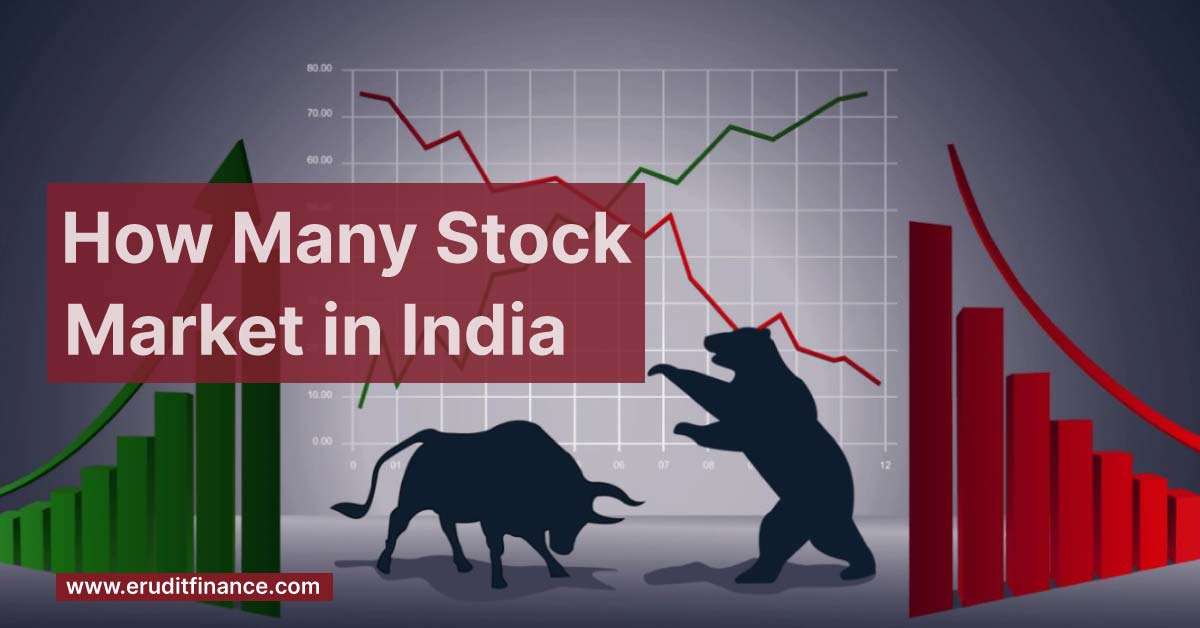Introduction
India boasts two primary stock exchanges, the Bombay Stock Exchange (BSE) and the National Stock Exchange (NSE), serving as pivotal pillars of the nation’s financial landscape. The BSE, established in 1875, is one of the oldest exchanges globally. On the other hand, the NSE, founded in 1992, has emerged as a technologically advanced and prominent player. Together, they facilitate the trading of a diverse array of stocks, derivatives, and other financial instruments, providing a platform for investors to participate in the vibrant Indian stock market and contributing significantly to the nation’s economic growth and development.
How Many Stock Market in India
According to the Securities and Exchange Board of India (SEBI), there are currently 23 functional stock exchanges in India. These are institutions recognized and regulated by SEBI, where members can trade various securities like stocks, bonds, and derivatives.
Number of all exchanges including inactive ones-
Including exchanges that are not currently functional or have been merged with others, the total number of listed stock exchanges in India may be higher. There is no definitive official source for this data, but some sources estimate it to be around 40. However, it’s important to focus on the functional exchanges that actively facilitate trading.
there are 23 functional stock exchanges in India, recognized and regulated by the Securities and Exchange Board of India (SEBI). Here’s a list of all of them.
National Stock Exchange (NSE)
| National Stock Exchange of India Ltd. (NSE) |
Regional Stock Exchanges (RSEs)
| Ahmedabad Stock Exchange Ltd. (ASE) | Bangalore Stock Exchange Ltd. (BSE) |
| Cochin Stock Exchange Ltd. (CSE) | Calcutta Stock Exchange Association Ltd. (CSE) |
| Coimbatore Stock Exchange Ltd. (CSE) | Delhi Stock Exchange Ltd. (DSE) |
| Guwahati Stock Exchange Ltd. (GSE) | Jaipur Stock Exchange Ltd. (JSE) |
| Inter-State Stock Exchange Ltd. (ISSE) | Ludhiana Stock Exchange Association Ltd. (LSE) |
| Indore Stock Exchange Ltd. (Indore SE) | Metropolitan Stock Exchange of India Ltd. (MSE) |
| Madras Stock Exchange Ltd. (MSE) | Mangalore Stock Exchange Ltd. (MSE) |
| Pune Stock Exchange Ltd. (PSE) | United Stock Exchange of India Ltd. (USE) |
| Uttar Pradesh Stock Exchange Ltd. (UPSE) | Multi Commodity Exchange of India Ltd. (MCX) |
| Universal Commodity Exchange Ltd. (UCX) | National Commodity & Derivatives Exchange Ltd. (NCDEX) |
| Indian Commodity Exchange Ltd. (ICEX) | ACE Commodity & Derivatives Exchange Ltd. (ACE) |
Please note that there have been historical mergers and closures of exchanges in India, which means the total number of exchanges might be higher if counting past entities. However, focusing on the currently functional exchanges is more relevant for understanding the active landscape of the Indian stock market.
What Are the 4 Main Stock Exchange in India?
The four main stock exchanges in India, also known as the “Big Four”, are-
- National Stock Exchange of India (NSE)- This is the largest and most active stock exchange in India, handling a significant portion of the total trading volume. It was established in 1992 and offers trading in equities, derivatives, and debt instruments.
- BSE Limited (formerly Bombay Stock Exchange)- Considered the oldest stock exchange in India, established in 1875, it still ranks among the leaderboards in terms of market capitalization and number of listed companies. BSE offers trading in equities, debt instruments, and mutual funds.
- Metropolitan Stock Exchange of India Ltd. (MSE)- Previously known as the Delhi Stock Exchange, MSE is a regional exchange established in 1992. It is the third-largest exchange in India by market capitalization and offers trading in equities, derivatives, and debt instruments.
- Calcutta Stock Exchange Association Ltd. (CSE)- This regional exchange, established in 1908, ranks as the fourth-largest stock exchange in India by market capitalization. It offers trading in equities and debentures.
Here’s a table summarizing the key information.
| Stock Exchange | Established | Location | Size and Importance |
| NSE | 1992 | Mumbai | The largest and most active exchange |
| BSE | 1875 | Mumbai | Oldest and second-largest exchange |
| MSE | 1992 | Delhi | Third-largest exchange |
| CSE | 1908 | Kolkata | Fourth-largest exchange |
It’s important to note that while these four exchanges dominate the market, other regional exchanges can be important for specific sectors or regions.
Who Is Owner of NSE?
The NSE, or National Stock Exchange of India, isn’t owned by a single entity in the traditional sense. Instead, it is a demutualized exchange, meaning it transitioned from a non-profit member-owned structure to a public shareholder-owned company in 2005. Therefore, the ownership of NSE is distributed among various financial institutions, public and privately owned entities, and individuals. Here’s a breakdown of the major shareholders.
1). Life Insurance Corporation of India (LIC)- LIC holds the single-largest stake at 10.7%.
2). Financial Institutions- Several banks and financial institutions like SBI Capital Markets, Stock Holding Corporation of India, and Veracity Investments collectively hold a significant portion of shares.
3). Public & private entities- Some public sector undertakings & private companies also hold ownership stakes.
4). Individual investors- A large number of individual investors hold smaller shares in the NSE.
No single entity or group has a controlling stake in the NSE, ensuring its governance and decision-making are not influenced by any particular shareholder interest. This structure is aimed at maintaining the fair and transparent functioning of the exchange.
What Is the Full Form of Nifty?
The term “Nifty” is derived from combining two words: “National” and “Fifty.” The full form of Nifty is “National Stock Exchange Fifty” or “Nifty Fifty.” Nifty is the flagship stock market index of the National Stock Exchange of India (NSE). It represents the performance of the 50 largest and most liquid stocks listed on the NSE, covering various sectors of the Indian economy. Nifty is widely used by investors and traders as a benchmark to gauge the overall performance of the Indian equity market.
What Is Sensex Full Form?
The term “Sensex” is a portmanteau of the words “Sensitive” and “Index.” The full form of Sensex is the “Sensitive Index.” Sensex is the benchmark stock market index of the Bombay Stock Exchange (BSE) in India. It represents the performance of the 30 largest and most actively traded stocks across various sectors listed on the BSE. The Sensex serves as a key indicator of the overall health and performance of the Indian stock market, providing insights into market trends and investor sentiment.
Who Controls Stock Market?
In India, the stock market is regulated and overseen by the Securities and Exchange Board of India (SEBI). SEBI is the statutory regulatory body that monitors and regulates the securities market, ensuring fair and transparent trading practices. Established in 1988, SEBI plays a crucial role in formulating and enforcing rules and regulations for stock exchanges, brokers, and other market participants. While SEBI sets the framework for market operations, the actual trading is conducted on stock exchanges such as the National Stock Exchange (NSE) and the Bombay Stock Exchange (BSE).
What Is the Old Name of BSE?
The Bombay Stock Exchange (BSE) was formerly known as “The Native Share & Stock Brokers’ Association.” It was established in 1875 as the first stock exchange in Asia. Over time, the exchange evolved and grew in prominence, eventually adopting the name Bombay Stock Exchange. In 2017, the BSE officially changed its name to BSE Limited to reflect its broader financial services and global presence.
Bottomline:-
India has two primary stock exchanges, the Bombay Stock Exchange (BSE) and the National Stock Exchange (NSE), serving as key pillars of the nation’s financial infrastructure. These exchanges collectively facilitate the trading of a diverse array of stocks and financial instruments, contributing significantly to India’s economic development and providing investment opportunities for market participants.
Also Read:-










